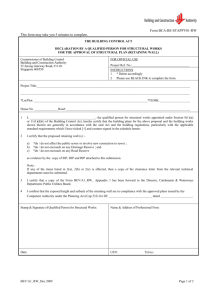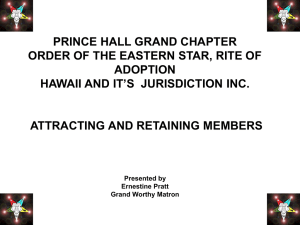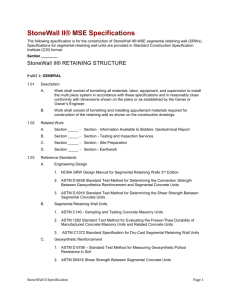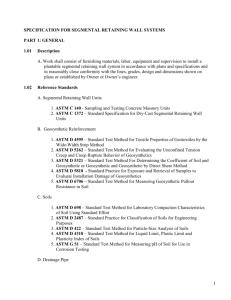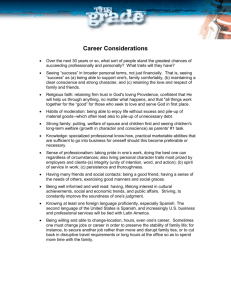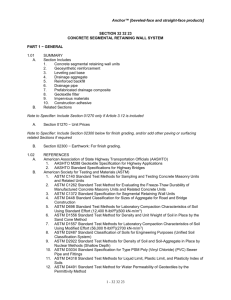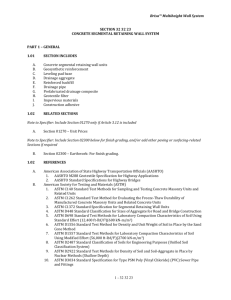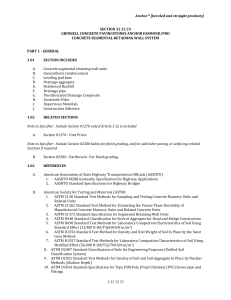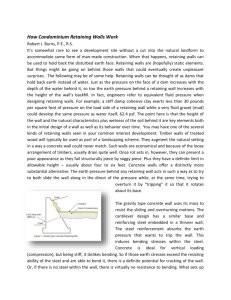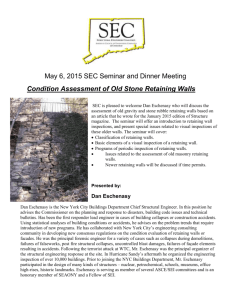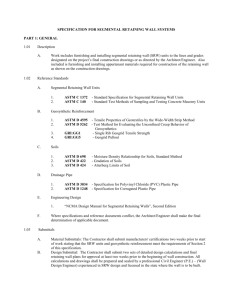Specification For Segmental Retaining Wall System
advertisement
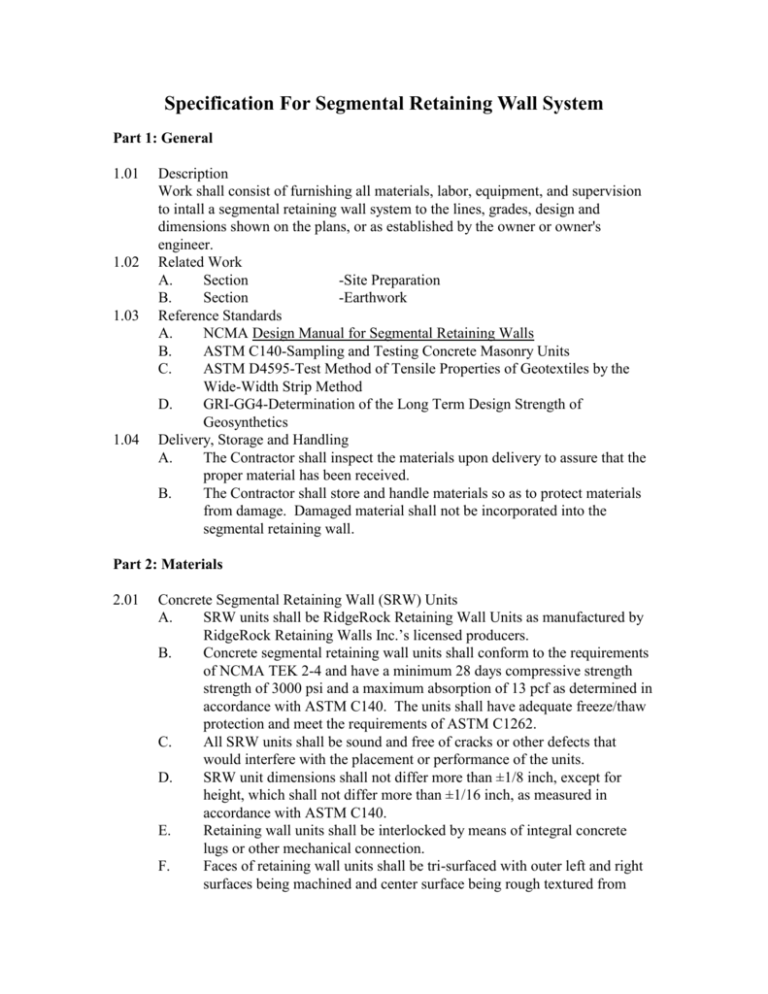
Specification For Segmental Retaining Wall System Part 1: General 1.01 1.02 1.03 1.04 Description Work shall consist of furnishing all materials, labor, equipment, and supervision to intall a segmental retaining wall system to the lines, grades, design and dimensions shown on the plans, or as established by the owner or owner's engineer. Related Work A. Section -Site Preparation B. Section -Earthwork Reference Standards A. NCMA Design Manual for Segmental Retaining Walls B. ASTM C140-Sampling and Testing Concrete Masonry Units C. ASTM D4595-Test Method of Tensile Properties of Geotextiles by the Wide-Width Strip Method D. GRI-GG4-Determination of the Long Term Design Strength of Geosynthetics Delivery, Storage and Handling A. The Contractor shall inspect the materials upon delivery to assure that the proper material has been received. B. The Contractor shall store and handle materials so as to protect materials from damage. Damaged material shall not be incorporated into the segmental retaining wall. Part 2: Materials 2.01 Concrete Segmental Retaining Wall (SRW) Units A. SRW units shall be RidgeRock Retaining Wall Units as manufactured by RidgeRock Retaining Walls Inc.’s licensed producers. B. Concrete segmental retaining wall units shall conform to the requirements of NCMA TEK 2-4 and have a minimum 28 days compressive strength strength of 3000 psi and a maximum absorption of 13 pcf as determined in accordance with ASTM C140. The units shall have adequate freeze/thaw protection and meet the requirements of ASTM C1262. C. All SRW units shall be sound and free of cracks or other defects that would interfere with the placement or performance of the units. D. SRW unit dimensions shall not differ more than ±1/8 inch, except for height, which shall not differ more than ±1/16 inch, as measured in accordance with ASTM C140. E. Retaining wall units shall be interlocked by means of integral concrete lugs or other mechanical connection. F. Faces of retaining wall units shall be tri-surfaced with outer left and right surfaces being machined and center surface being rough textured from 2.02 2.03 hard splitting. Imitation raked surfaces will not be permitted. G. Cap adhesive shall meet the requirements of the retaining wall supplier. Geosynthetic Reinforcement A. Geosynthetic Reinforcement shall consist of those high strength geogrid or geotextiles designed for use in segmental retaining wall systems. B. The geosynthetic type, strength and placement shall be as shown on the plans. The design properties of the geogrid/segmental block system shall be determined by the procedures outlined in the Geosynthetic Research Institute, GRI-GG4, and NCMA SRWU-1. Drainage Aggregate Drainage aggregate shall be a clean crushed stone or granular fill meeting the following gradation: Sieve Size 1 inch 3/4 inch No. 4 No. 40 No. 200 2.4 2.5 Percent Passing 100 75-100 0-60 0-50 0-5 Reinforced Backfill The reinforced backfill shall be free of debris, and consist of inorganic, low plasticity soil with a minimum angle of internal friction of 28°, and a liquid limit less than 50. Drainage pipe A. The drainage collection pipe shall be perforated or slotted, PVC or corrugated HDPE pipe. B. Drainage pipe shall be manufacturered in accordance with ASTM D 3034 and/or ASTM D 1248 Part 3: Installation 3.01 3.02 3.03 Excavation A. Contractor shall excavate to the lines and grades shown on the grading plans. Foundation Preparation A. The foundation soil shall be excavated to the leveling pad dimensions indicated on the plans. B. The foundation soil shall be evaluated by the engineer to confirm the design bearing strength of the foundation soils. Soils not meeting the design bearing strength shall be replaced with suitable fill. Leveling Pad Installation A. A minimum 6 inch thick layer of compacted granular material shall be placed as shown on the construction drawings. B. The granular base shall be compacted to 95% of the maximum Standard 3.04 3.05 3.06 3.07 Proctor density. The base shall be capable of providing a firm level bearing pad on which to place the first course of RidgeRock Segmental Retaining Wall Units. Retaining Wall Unit Installation A. All materials shall be installed at the elevation and orientation shown on the plans. B. The retaining wall units shall be installed adjacent to each other along the alignment of the wall. C. Fill the RidgeRock Retaining Wall Units with drainage aggregate (Section 2.03). D. Extend the drainage aggregate a minimum of 12 inches behind the retaining wall units. E. Clean the top of the units so that they are free of aggregate. F. Offset the second course of RidgeRock units, and pull them forward, so that the RidgeRock connector engages with the lower RidgeRock course. Repeat the above procedure until the proper height is achieved. G. Terminate the end of the wall by turning the units at a radius into the embankment or tapering the top of wall with the desired slope. Cap Unit Installation A. Place the Cap Unit over the last course of retaining wall units. B. Saw cut block as needed. C. Use a high strength cap adhesive to bond the cap unit to the wall. Geosynthetic Installation A. Install the geosynthetic reinforcement at the elevations shown on the construction drawings. B. The geosynthetic shall be installed by placing the primary strength direction of the product over the RidgeRock Unit (extended to the face of the unit), placing the next course of retaining wall units over the geosynthetic and pulling the geosynthetic taut. Anchor the end of the geosynthetic with pins or stakes to maintain tension prior to fill placement. Backfill Placement A. The backfill shall be placed in maximum loose lift thicknesses of 10 inches, and compacted to 95% of Standard Proctor density (ASTM D 698) at a moisture within 2% of optimum. B. Backfill shall be spread and compacted in such a manner that eliminates the development of slack in the geosynthetic. C. Only hand operated compaction equipment shall be allowed within 3 feet of the front of the wall face. D. Tracked construction equipment shall not operate directly upon the geosynthetic reinforcement. A minimum backfill thickness of 6 inches is required prior to operation of tracked vehicles over the geosynthetic reinforcement. Turning of tracked vehicles shall be kept to a minimum to prevent fill and geosynthetic displacement. E. Rubber tired equipment may pass over the geosynthetic reinforcement at slow speeds less than 10 mph. Sudden braking and turning must be 3.08 avoided. F. At the end of the day's operation, slope the backfill away from the wall to direct runoff away from the wall face. The contractor shall not allow surface runoff to enter the wall construction site. Drainage Fill Placement A. The drainage fill shall be placed as directed on the construction plans. B. Install a minimum 3 inch drainage pipe behind the base of the wall to collect drainage from the drainage fill. The drainage collection pipe should daylight into a storm sewer manhole or along a slope at an elevation which is at a lower elevation than the lowest point within the aggregate drain. C. Drainage laterals shall be placed at a maximum of 50 feet spacing along the wall face. Part 4: Measurement and Payment A. The unit of measure for furnishing the RidgeRock Retaining Wall System shall be the vertical projected face area from the top of the leveling pad to the top of the cap unit. The quantity to be paid shall include design, supply and installation of the RidgeRock Retaining Wall system. Excavation of unsuitable materials and replacement with select fill shall be paid for under separate pay items. B. Payment will be made under Pay Item: RidgeRock Retaining Wall, and Pay Unit: SQ.FT.
